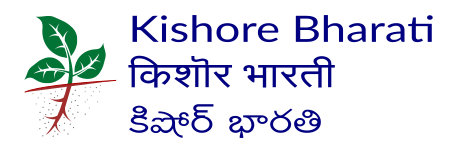Kishore Bharati started as an experiment in education and development with its origins in oshangabad district, Madhya Pradesh in the year 1971. It is aimed at creating an education system interweaving natural and social sciences through grassroots engagement. For a detailed description of the history of this project please read the page Hoshangabad Science Teaching Program (HSTP).
The current crises in health and the environment; creative education and participatory development; etc., cannot be addressed unless both socio-cultural and scientific approaches are in constant dialogue with each other.
We, therefore, work by establishing functional relationships with the community without any touch of charity, patronage, or dependence on Kishore Bharati, which strives to encourage local initiatives by networking with grassroots organizations. Currently, Kishore Bharati is actively engaged in creating a network of Home Labs across the country to address creative education issues in collaboration with Gnowledge Lab of Homi Bhabha Centre for Science Education, TIFR. Read more on the Home Labs on Collaboratively Understanding Biology Education (CUBE) page.
As an organization that functions through the voluntary involvement of passionate participants, we invite you to join us in this mission.

Hoshangabad Science Teaching Programme (HSTP)
Hoshangabad Science Teaching Program (HSTP) was an initiative to improve science teaching and learning at school levels and develop innovative and interactive ways of school science teaching. The HSTP project till today is still arguably one of the largest science education experiments ever conducted. Read more about HSTP

. Nai Taleem
The ideas of Nai Taleem as practiced by Jyotirao and Savitribai Phule and later articulated by Mahatma Gandhi and Paulo Friere, Ivan Illich and several others who imagined alternative schools for social transformation as against supportive institutions for industrialization, were implemented in a six-year non-formal educational program. Read more about Nai Taleem

Collaboratively Understanding Biology Education (CUBE)
In collaboration with the gnowledge lab of Homi Bhabha Centre for Science Education, we currently organize the CUBE (Collaboratively Understanding Biology Education) program. Thousands of students participate in CUBE projects from across the country to create home labs and enhance the quality of engagement in existing school and college labs. Read more about CUBE

How to make a home lab?
Living Academy
The Living Academy will be created for transfer of knowledge and pedagogical practices and work at the intersection of research and practice. The academy will have multiple studios starting with the following:
● Makerspace for Construction as a context for learning
● STEM Lab for research as a context for learning
● Digital Makerspace and Digital Science Labs for construction and research in a digital space.
Textbooks

Other publications
As a part of the HSTP project, with support from SCERT Madhya Pradesh, a collection of books were developed in Hindi and English for the schools in Madhya Pradesh. These books have a wealth of project-based and activity/enquiry-based curriculum. Read more. Find more publications of KB
